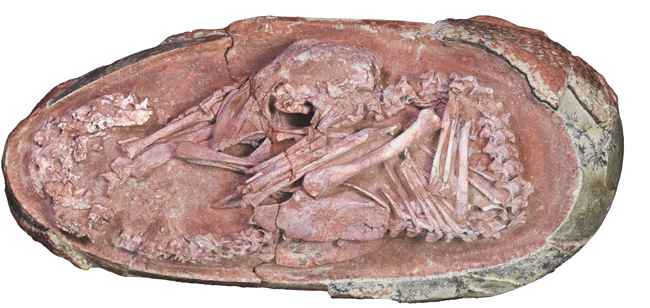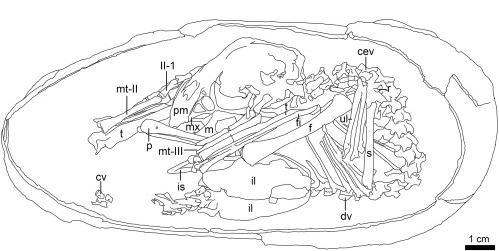An exquisite dinosaur embryo from southern China has shed new light on the evolutionary link between the Dinosauria and modern birds. The beautifully preserved embryo of an oviraptorosaur has a posture inside the egg reminiscent of a late-stage modern bird embryo. This pre-hatching behaviour, previously considered unique to the Aves (birds), originated in the Theropoda.

“Baby Yingliang”
Writing in the journal “iScience”, the researchers who include Professor Lida Xing from the China University of Geosciences (Beijing), Professor Steve Brusatte (University of Edinburgh) and PhD student Fion Waisum Ma (University of Birmingham), describe the dinosaur embryo, nicknamed “Baby Yingliang”. Study of the fossilised remains preserved inside the egg (in-ovo), demonstrates that the head of the baby dinosaur lies ventral to the body, with the feet on either side and the back is curled along the blunt end of the egg. This posture had not been recorded in dinosaur embryos before. In modern birds, this posture is referred to as “tucking”. It is a behaviour controlled by the central nervous system and is critical for hatching success.

An Oviraptorosaur Embryo
The fossil comes from Upper Cretaceous deposits from Ganzhou Province (southern China). It is believed to be between 72 and 66 million years old. Lead author of the study, Professor Lida Xing explained that the fossil was acquired by the director of Yingliang Group, Mr Liang Liu, during the construction of Yingliang Stone Nature History Museum.
The embryo is articulated in its life position without much disruption from fossilisation. It has been identified as an oviraptorosaur, a toothless theropod dinosaur and a member of the Maniraptora. It was closely related to the dinosaur lineage that led to modern birds. The elongatoolithid egg measures 17 cm in length and the embryo inside measures 27 cm long.
Joint first author of the scientific paper, Fion Waisum Ma stated:
“Dinosaur embryos are some of the rarest fossils and most of them are incomplete with the bones dislocated. We are very excited about the discovery of ‘Baby Yingliang’. It is preserved in a great condition and helps us answer a lot of questions about dinosaur growth and reproduction. It is interesting to see this dinosaur embryo and a chicken embryo pose in a similar way inside the egg, which possibly indicates similar prehatching behaviours.”
Plotting the Evolution of “Tucking” Behaviours
Birds develop this tucking posture, prior to hatching. Embryos that fail to adopt this posture have a higher chance of dying during the hatching process. By comparing this oviraptorosaur embryo with the embryos of other theropods, long-necked sauropod dinosaurs and birds, the researchers postulate that tucking behaviour, which was considered unique to birds, first evolved in theropod dinosaurs. Pinning down just when in geological time this behaviour evolved is dependent on the discovery of more dinosaur embryo fossils.
Co-author of the study, Steve Brusatte commented:
“This dinosaur embryo inside its egg is one of the most beautiful fossils I have ever seen. This little prenatal dinosaur looks just like a baby bird curled in its egg, which is yet more evidence that many features characteristic of today’s birds first evolved in their dinosaur ancestors.”
Everything Dinosaur acknowledges the assistance of a media release from the University of Birmingham in the compilation of this article.
The scientific paper: “An exquisitely preserved in-ovo theropod dinosaur embryo sheds light on avian-like prehatching postures” by Lida Xing, Kecheng Niu, Waisum Ma, Darla K. Zelenitsky, Tzu-Ruei Yang, Stephen L. Brusatte published in iScience.
Visit the Everything Dinosaur website: Everything Dinosaur.







Leave A Comment